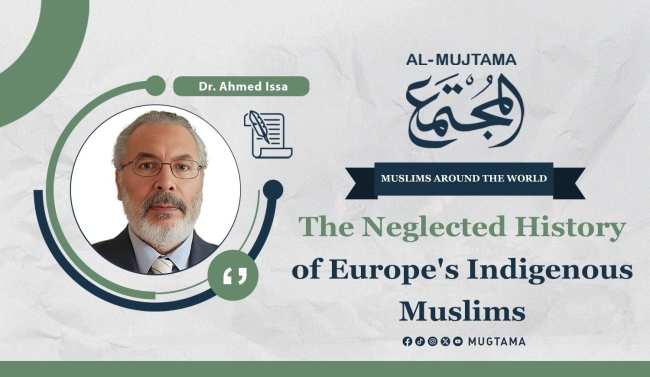The Neglected History of Europe's Indigenous Muslims
Many people believe that Muslims began migrating to Europe in the 20th century. However, many professional historians, politicians, and media figures in Europe—not just ordinary citizens—express discontent when it's stated that the Islamic presence in Europe has existed for over 1400 years, since the mid-7th century. So, what does history tell us?
History records that Muslims were the original inhabitants of many areas of Europe who converted to Islam voluntarily, often before Europeans embraced Christianity, and that the two religions originated outside Europe. For example, Christianity entered Russia and Crimea when Vladimir I of Kiev converted in 988 CE, and before that, they worshiped natural forces.
The first European Islamic state emerged in the South Caucasus in the mid-7th century and later in the southern Iberian Peninsula (Al-Andalus) at the beginning of the 8th century. However, European educational curricula and media often ignore these facts or mention them casually.
During periods of both direct and indirect rule, these states included vast areas of northern Europe, such as parts of Russia, including Moscow. In the south, they covered southern France, southern Italy, southern Switzerland, and all the major Mediterranean islands, including Cyprus, Rhodes, Crete, Malta, Sicily, Sardinia, Corsica, and Majorca, as well as the entire Balkans, Hungary, and the outskirts of Vienna. (1)
- Caucasus:
The Caucasus is located between the Caspian Sea to the east and the Black Sea to the west. The establishment of the first Islamic state on European soil dates back to 653 CE, when an Islamic emirate was founded in the southern Caucasus. This was preceded by the first organized arrival of Muslims in Europe in 641 CE, when the companion Abdurrahman bin Rabiah Al-Bahili took control of areas in the southern Caucasus. According to his testimony, he encountered a Muslim community living there upon his arrival. (2)
The first Islamic state on European soil was established in 653 AD, when an Islamic emirate was founded in the southern Caucasus.
According to Muslim historians, the conquests lasted for 10 years between 22-32 AH / 642-652 CE. Ibn Kathir mentioned that Al-Bahili marched into Balanjar (Caucasus), covering a distance of 200 parasangs (a historical length unit). (3) Al-Tabari stated: Invaders conquered Balanjar during the time of Umar, where no woman was widowed, no child was orphaned, and the cavalry covered a distance of two hundred parasangs in Balanjar.” (4)
Accordingly, Al-Bahili advanced northward, covering a distance of 950 kilometers, indicating the Islamic conquests reached the region of Volgograd in south-central Russia today.
The second wave of conquests occurred between 722 and 737 CE, culminating in the defeat of the Khazars (between the river mouths of the Volga and Don rivers) at the hands of Marwan ibn Muhammad (during the reign of Hisham ibn Abd al-Malik). Despite their victory, Muslims were unable to eliminate the Khazar kingdom. (5)
Scholars studying Eastern Europe know that Islam began to penetrate the Khazar Kingdom in the 8th century. By the early 11th century, it had become the religion embraced by the largest number of people, although it was not necessarily politically powerful. They also recognize that Islam spread in the Volga Bulgarian kingdom in Russia towards the end of the 9th century and the first half of the 10th century and was established firmly. (6)
The Mufti of Russia states: “Islam was declared the religion of the state in Volga Bulgaria in 922 CE, 66 years before Orthodox Christianity became the official religion of Kievan Rus,” and he adds: “Islam reached Russia in the 7th century CE, when followers of the Prophet Muhammad (peace be upon him) arrived in a city now known as Derbent, located in southern Dagestan, where the first adhan (call to prayer) was made.” (7)
- Al-Andalus:
The Islamic state was established on European soil in Spain before the Christian kingdom of Charlemagne, with a papal bull, half a century later. The Islamic State of Al-Andalus, with its capital in Cordoba under the rule of Emir Abd al-Rahman ibn Muawiya from the Umayyad dynasty, was founded in 756 CE. The conquest began in 92 AH / 711 CE, and by 720 CE, most of Spain was under Muslim control.
The Islamic state was established on European soil in Spain half a century before the Charlemagne Christian kingdom.
Historical data confirm the failure of the claim that Europe is exclusively a Judeo-Christian continent. The majority of Europe (including all of Scandinavia, which began its conversion from paganism to Christianity late in the 10th and 11th centuries, along with northern, central, and eastern Europe, as well as Russia and Ukraine) remained pagan for many centuries, even after wide areas of Europe accepted Islam and several Islamic states were established in Europe. Al-Andalus was economically and culturally the most developed among European countries and the strongest militarily. (8)
- Crimea:
The Crimean Peninsula extends into the Black Sea. Islam reached it through the Tatars, during the era of the Golden Horde or Northern Mongols, as their first tribes embracing Islam. They trace their lineage back to Jochi, the eldest son of Genghis Khan. When Jochi died, his father granted his grandson (Batu) control over the lands of Russia, Khwarazm, the Caucasus, and Bulgaria. Batu expanded his territories and seized the city of Kiev in 1240 CE. At the peak of their expansion, their territories stretched from the Carpathian Mountains in Eastern Europe (between the Czech Republic, Poland, Slovakia, and Hungary) to the plains of Siberia. Berke Khan (Batu's brother) completed the construction of their capital city, Sarai, on the Volga River in the European part (Saratov in Russia). He built mosques and Islamic schools there, attracted scholars, and made it one of the largest cities in the world. Ibn Battuta described it as “one of the finest cities, with great markets built on the Atil river (Volga).” (9)
Islam reached the Crimean Peninsula through the Tatars during the era of the Golden Horde, as their first tribe embracing Islam.
When the Tatars arrived, they attracted Greeks and Italians living there to Islam and invited their neighbors to it. The Crimean state then became independent under the rule of Giray (1427 CE), expanding its influence. Its strength was such that the Principality of Moscow paid an annual tribute to Sultan Mehmed Giray. Later, Moscow submitted to his rule in 1571 CE. (10)
- Sicily:
Muslims first entered the land of Sicily, the largest island in the Mediterranean Sea, in the year 652 CE. After a long siege in 831 CE, Muslims entered the capital, Palermo. Sicily came under the rule of the Kalbid dynasty in 948 CE, reaching its peak as architectural, cultural, and commercial activities flourished, elevating the quality of life and prosperity to unprecedented levels. A contemporary historian of that era remarked: “Palermo truly became one of the most advanced and largest cities in Europe, with over 300,000 inhabitants and 300 mosques. It was the true capital of the Islamic world in Europe.” (11)
Muslims first entered the land of Sicily, the largest island in the Mediterranean Sea, in the year 652 CE, which has the largest cities in Europe.
- Balkans:
The Balkan Peninsula, a cultural and geographical region known as Southeast Europe, is located in Eastern Italy and Northwestern Anatolia. The history of Islamic influence and its active presence in the region dates back to the second half of the 7th century CE, contrary to common and mistaken claims of ignorance and neglect stating that Islam did not reach the Balkan Peninsula until the time of the Ottomans. Modern studies unequivocally confirm that Islam had established its roots in the Balkans before the Ottomans arrived. During this period, Muslims settled along the southern coast of Thrace (shared by Bulgaria, Greece, and Turkey), in the Gulf of Thessaloniki (in Greece), along the eastern coast of Albania, and in parts of what is now Croatia.
With the advancement of the Ottoman Empire from the 13th to the 15th centuries, these Muslim communities interacted strongly among themselves, evolving politically and economically into urban and administrative centers of Islamic culture. During the reign of Sultan Selim II (1524-1574 CE), there was a significant increase in the Muslim population through voluntary mass conversion of indigenous populations in Bulgaria, Romania, Greece, all major islands, Albania, Bosnia, Serbia, and parts of Croatia and Slovenia. Thus, the demographic foundations were laid for the presence of indigenous Muslims in this part of Europe today. (12)
The history of Islamic influence and active presence in the Balkans dates back to the second half of the 7th century CE.
When we consider that the presence of Muslims with their culture and religion throughout these mentioned regions consistently formed one of the most important elements of their identity, it becomes obvious that the demographic-geographical reality, ethnic, religious, moral, scientific progress, political, economic, and military composition in Europe cannot be separated at all from Islamic elements. Muslims have been and continue to be an integral, influential, and significant part of the European fabric. Even if people attempt to forget, history never forgets!
-------------------------------------------------------------
- Ferid Muhić, The Islamic Components of Europe's Identity, Beirut: Arab Scientific Publishers, 2016, p. 275.
- Haverić, History of the Muslim Discovery of the World, Deakin University, 2012.
- Ibn Kathir, Al-Bidaya wal-Nihaya, Cairo: Al-Saada Printing House, Vol. 7, p. 123.
- Al-Tabari, History of the Prophets and Kings, Dar Al-Ma'arif, 1967, Vol. 4, p. 158.
- El-Messiri, Encyclopedia of Jews, Judaism, and Zionism, Vol. 3, p. 410.
- Sartawi, Islam in Eastern Europe at the Time of the Mongol Invasion, Al-Risala Magazine, Issue 969, p. 14.
- Elena Teslova, “Russian Mufti: We Have 25 Million Muslims Living with the Rest of Society,” Anadolu Agency, March 11, 2018.
- Muhić, p. 20.
- Ibn Battuta, The Travels of Ibn Battuta, Rabat: Academy of the Kingdom of Morocco, 1417 AH, Vol. 2, p. 240.
- Encyclopedia Britannica, “Golden Horde,” December 6, 2023.
- Bernard Lewis, The Arabs in History, Oxford University Press, 2002: 94-95.
- Muhić, p. 275.


